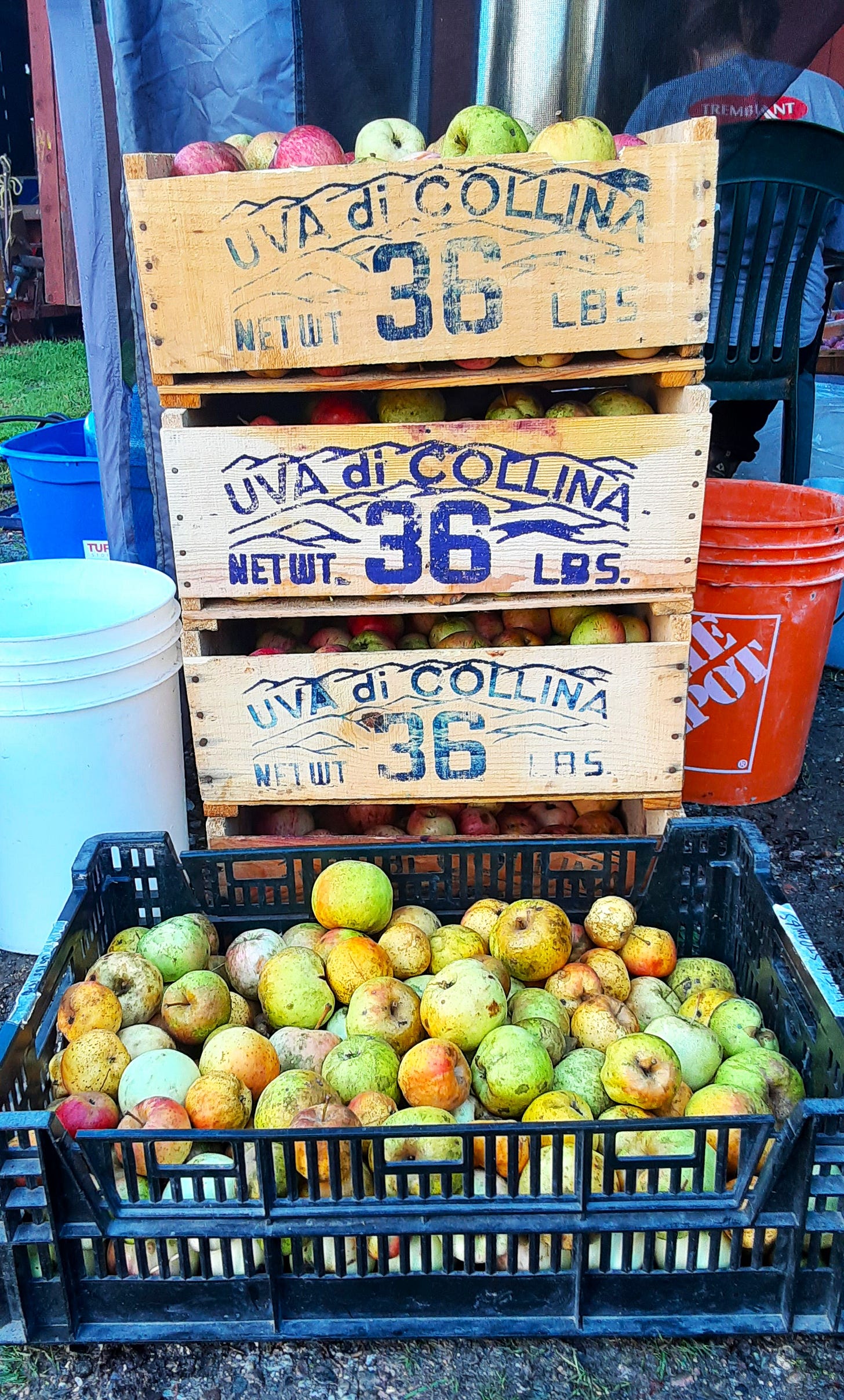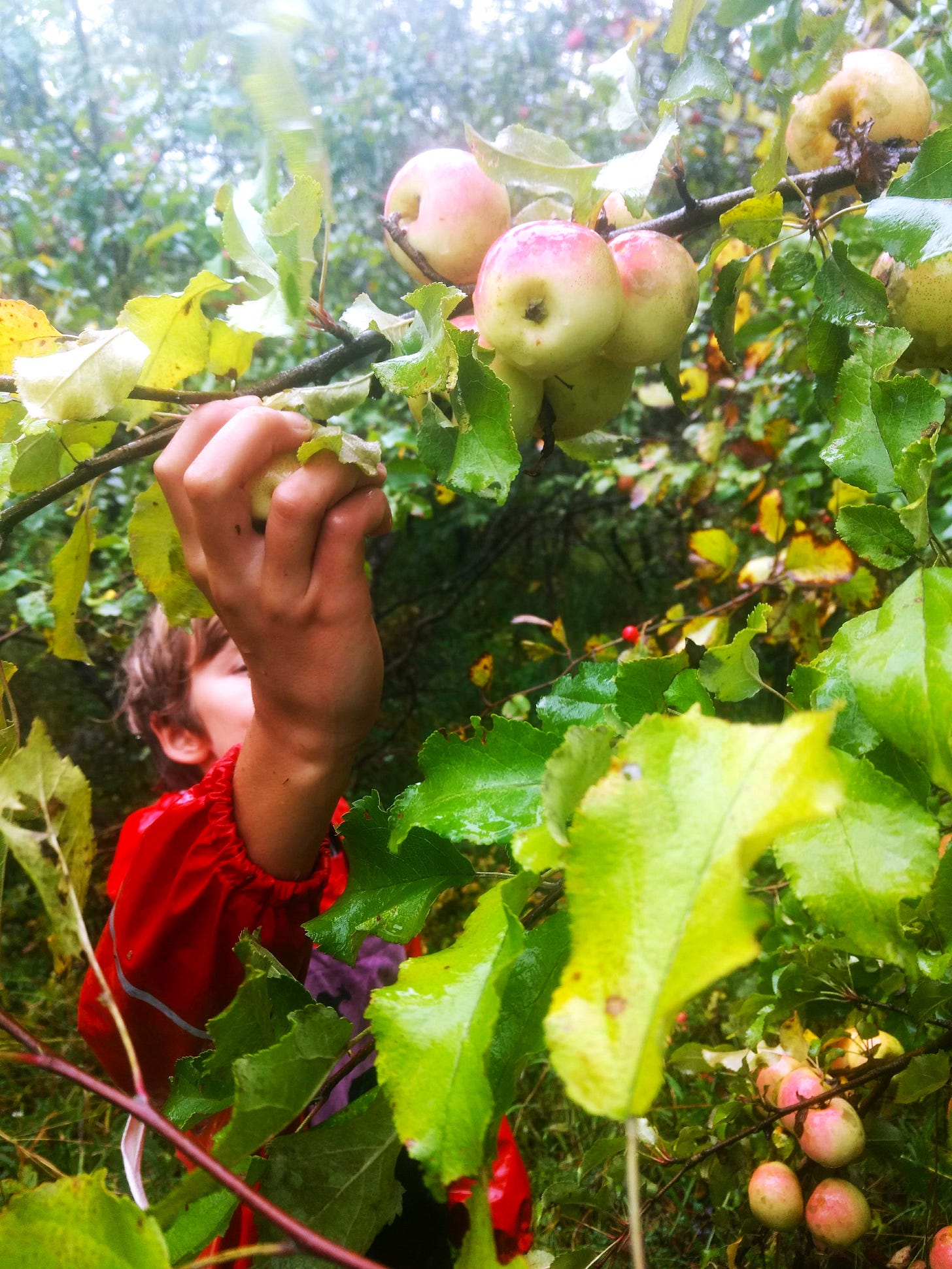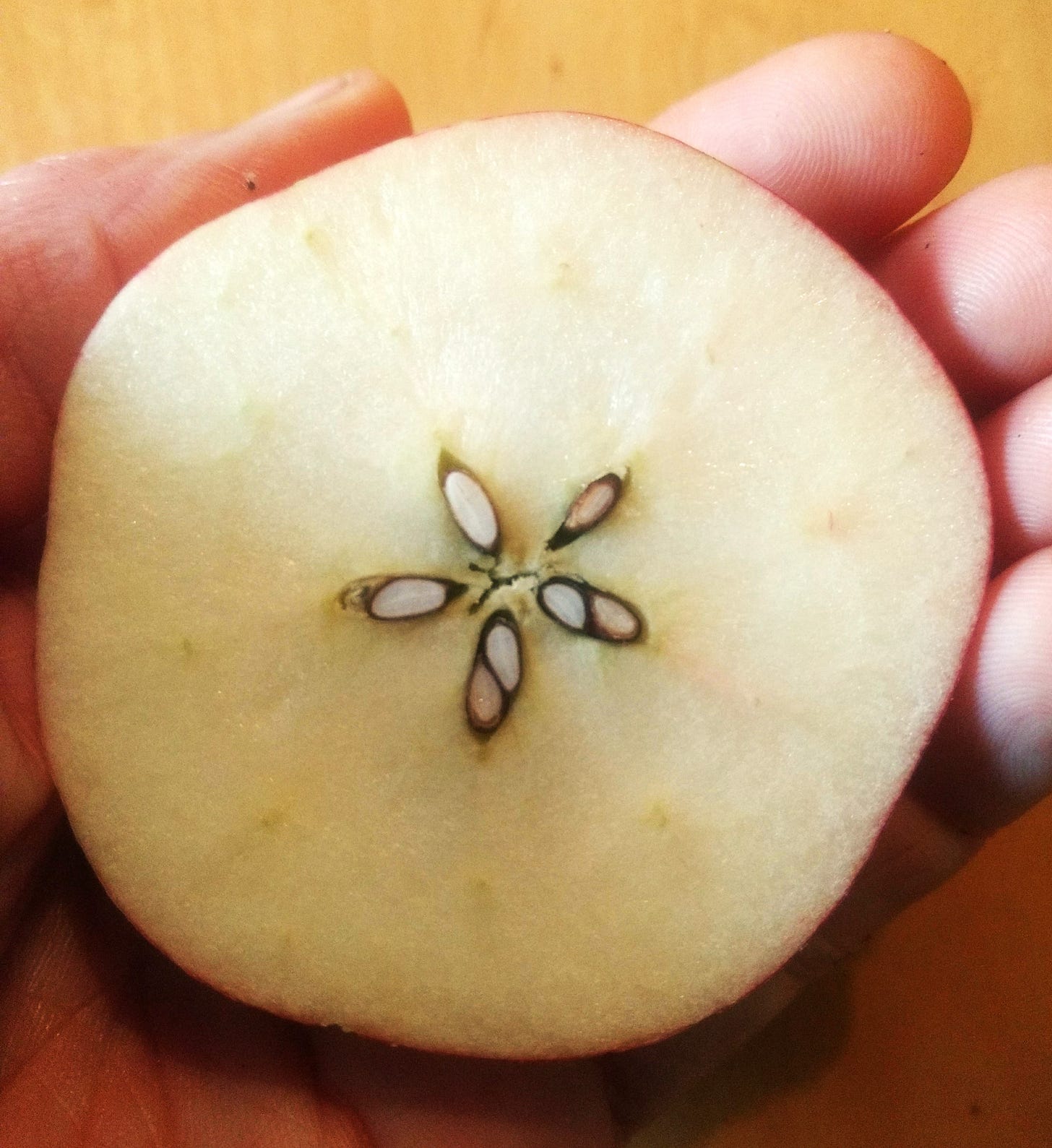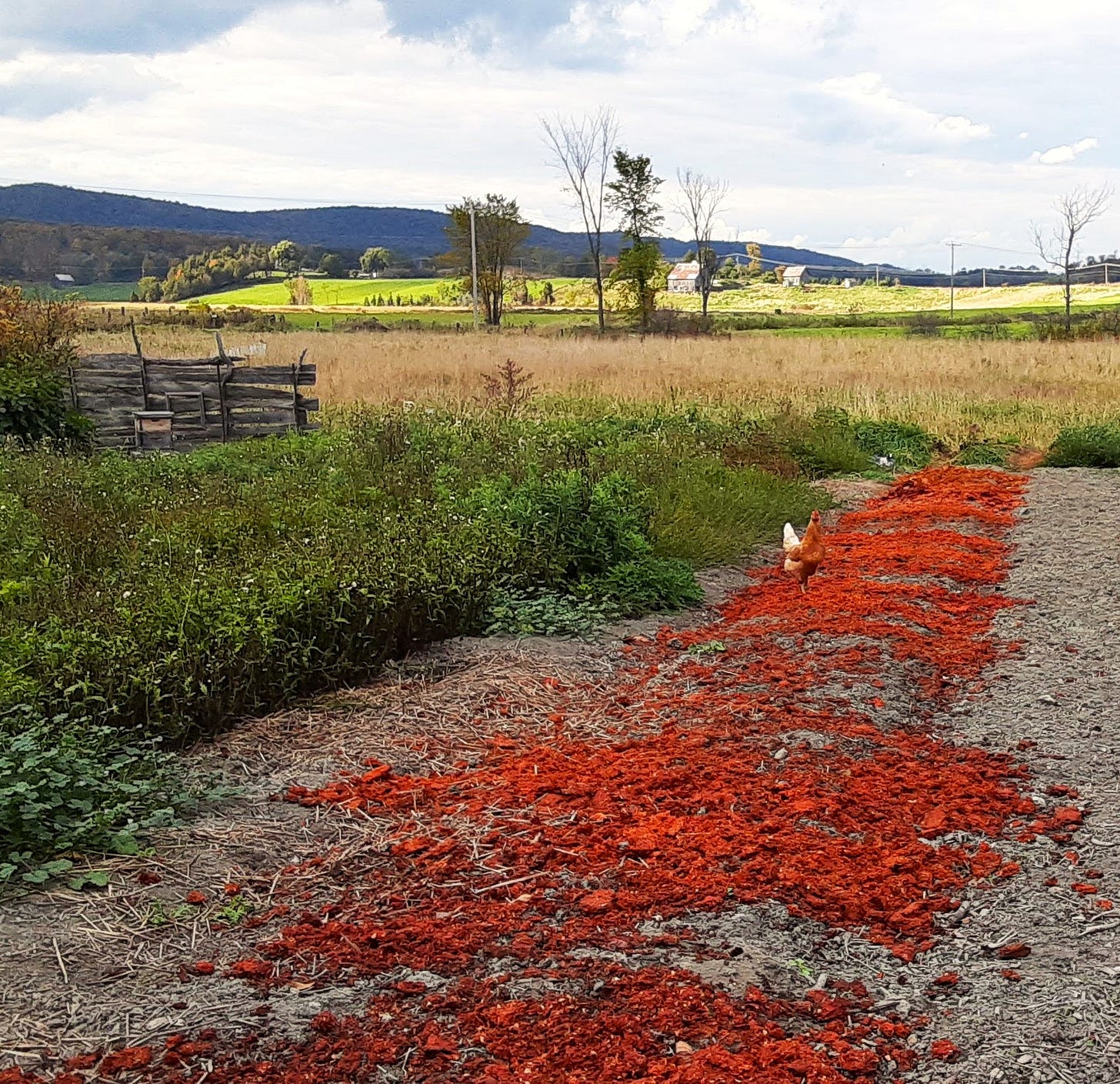The Feral Orchard Next Door
Emergent Possibilities: How Did It Happen, and How Can It Be Replicated?
Our 2024 apple season has drawn to a close. Two days ago, I picked the last of the apples. Yesterday, we finished pressing them into cider. It wasn’t a record-busting year like last year, but it was still decent: we picked 80 bushels, started nine carboys to ferment into vinegar and hard cider, and put the rest in one-litre plastic bottles to freeze and sell over the coming year. We also juiced a lot of other people’s apples (and even some pears) with our hydro press for them to take home and enjoy.
As has been the case for many years now, our next door neighbours at Ferme Art Nature let us harvest their wild-growing apples in exchange for pails full of cider for themselves. I am constantly in awe of their wild orchard. Over eight acres, hundreds of apple trees have sprung up, each one genetically unique, each one producing its own variety of apple, its own take on the apple theme, riffing endlessly on the possibilities of appleness. Tart, bitter, sweet, hard, soft, red, yellow, green, scabby, bruising, splitting, mealy, big, small, round, irregular, resistant, in a never-ending churn of kaleidoscopic expression.
While most of these apples make poor eating fresh, the miracle of cider is that when you mix them all together and press their juice, you get something delicious. It’s like a Hollywood movie, where a band of misfits come together and win the championship. Its lead actor is sweet, but there’s a supporting cast of sour and tannins to give it depth and character. Someone at market once referred to our cider as “apple juice”. I was insulted. Apple juice is cider that has been pasteurized, and in the process stripped of most everything but an insipid sweetness. Cider, the unpasteurized product of apples squeezed at high pressure, is Apple in all its divine fullness. It is a warm embrace of the tongue (and even better when actually warmed). People who taste it straight from the press are always mesmerized.
But I understand the lexicographic confusion; in English, “cider” both refers to what I described above, and the alcoholic drink that results from letting it ferment. In French, they just have the words “jus” to describe the non-fermented product, and “cidre” to describe the fermented one. While the French approach reduces the hazard of accidentally getting your kids drunk, it doesn’t differentiate between the pasteurized and non-pasteurized versions of the non-fermented drink — a cardinal sin, in my opinion. It’s a bit more clunky, but if our meaning is in doubt, in English we can always add the descriptors “sweet” or “hard” before the word “cider” to let people know if we prefer our sugars in their original form or transformed into alcohol.
I’m not aware of any words to describe the spectrum of drinks available between a sweet and a hard cider. Sweet cider wants to become hard cider (and then wants to become apple cider vinegar); the yeasts that will eat the sugar and excrete alcohol (yes, alcohol is their poo) are present on the skins of the apples. Once you chop them up and squeeze their juice, that yeast is raring to go. There’s nothing hard about making hard cider. Sweet cider not preserved in any way (there are ways to do this other than pasteurization — UV rays, for instance) and left in the fridge for even a week will start to get bubbly and taste a bit sharp. I know people who let this happen on purpose and enjoy the slightly alcoholic beverage. Leave sweet cider on your counter and taste it each day to get the full sample of flavours as cider progresses from sweet to hard. A temporal flight.
I’d like to eventually be able to sell hard cider at the farm. We’ve got a great view of the valley — how enjoyable would it be to sit on a nice terrace, sipping some fine cider, maybe with a little food to compliment, enjoying the company of friends while watching the sun set over the green of the fields and forested hills? That’s my bucolic vision. But to legally be able to sell cider — the hard stuff — from our farm, we need to grow the apples on our land. Harvesting from our neighbour’s doesn’t cut it. So I’ve been trying to establish an apple orchard here. And I don’t want to buy a bunch of expensive grafted seedlings from some nursery, and put all the effort into protecting them from deer and weeds, only to have most of them die before producing any fruit, as has happened with so many of the other fruit trees we’ve tried growing here. I want to reproduce the orchard next door. I want an orchard of seedling-grown (in other words, genetically diverse) apple trees that are adapted to our bioregion.
This begs the question: “How did that mystical feral orchard next door self-establish?” When I first saw that field back in 2001, a fresh-faced immigrant to the Gatineau Hills, it was a horse pasture, with nary a tree in sight. Here’s my best theory for what happened next: the horses were fed apples; the horses pooped the seeds out, packaged in balls of natural fertilizer (unlike cows, horses only have one stomach, so most seeds pass through their digestive system still viable); the seeds sprouted; the horses, preferring grass to woody plants, didn’t eat the new seedlings, but did mow the grass around them; and the horses also scared the deer away. Viola, orchard. A perfect example of how animals can shape their environment. All I would need is a couple of horses, a constant input of apple treats, and time.
But I chose, perhaps unwisely, to go a different route. I wanted rows, to ease in harvesting, and didn’t really feel like getting into horse ownership. So I began by tilling up one hectare (2.5 acres) and laying down plastic along seven rows, spaced 30 feet apart (plus an eighth row of windbreak trees like pine, spruce, and oak). I tried to leave the plastic down long enough to kill the grass, but left it too long, and it was a huge pain to remove, because the aggressive quack grass roots had formed a matrix over the edges of the plastic, which we had buried to hold it down. Once I finally got rid of the plastic, I spread the pomace (the leftover pulp, full of seeds, from our pressing) along these rows. I “planted” densely, hoping to overwhelm with sheer numbers the challenges that would inevitably face these new trees as they grew up; I would thin the survivors to appropriate spacings later. I also tried starting some seeds in nursery beds, then transplanting them into this aspirational orchard. This process took several years to roll out. Alas, the plastic did nothing to deter the grass long term, and the deer have been pruning off most of the new growth of my few tiny seedlings with an almost obsessive zeal — when they can find them in the tall grass. Without these challenges, an apple tree should take about a decade between sprouting and producing its first apples. So when people ask me how long until my orchard starts producing, and the cider starts flowing, I always answer, “10 years”. But lately, people have been catching on that I’ve been giving them that same answer for five years now. I’ve finally realized that a change of strategy is in order. My maximally low-effort approach might mean I never see this orchard produce in my lifetime.
So I’ve decided to up my game. This year, I “planted” our pomace in a nursery bed. The fact that we decided to get out of growing garlic this year provided a golden opportunity to turn the space we had prepared for this fall’s garlic planting into an apple tree kindergarten. I’ll let the trees grow there for a year or two (protecting them from deer with electric fence). Then I’ll transplant them to the orchard, spaced 20 feet apart. I need about 200 trees to do this. This time, I’ll actually put deer protection around each tree (plastic mesh tubes that protect the seedling until it has grown above deer browsing height), mulch with wood chips around their bases, and mow the grass occasionally. I guess kids do need at least a little nurturing to get them off to a good start.
So — mark your calendars — I’ll see you at our cidery’s grand opening in 2034!






